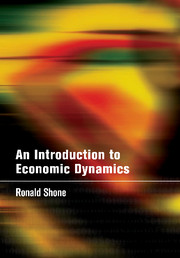Book contents
- Frontmatter
- Contents
- List of tables and boxes
- Preface
- 1 Introduction
- 2 Demand and supply dynamics
- 3 Simple Keynesian dynamics
- 4 Constructing trajectories in the phase plane
- 5 IS-LM dynamics
- 6 Inflation–unemployment dynamics
- 7 Dynamics of the firm
- 8 Saddles and rational expectations
- 9 Fiscal dynamics and the Maastricht Treaty
- 10 A little bit of chaos
- Brief answers to selected exercises
- Further reading
- Index
Preface
Published online by Cambridge University Press: 05 June 2012
- Frontmatter
- Contents
- List of tables and boxes
- Preface
- 1 Introduction
- 2 Demand and supply dynamics
- 3 Simple Keynesian dynamics
- 4 Constructing trajectories in the phase plane
- 5 IS-LM dynamics
- 6 Inflation–unemployment dynamics
- 7 Dynamics of the firm
- 8 Saddles and rational expectations
- 9 Fiscal dynamics and the Maastricht Treaty
- 10 A little bit of chaos
- Brief answers to selected exercises
- Further reading
- Index
Summary
This is a short book. It aims to get across the essential elements of dynamics that are used in modern treatments of the subject. More significantly, it aims to do this through the means of examples. Some of these examples are purely algebraic. But many others consider economic models: both microeconomic and macroeconomic. Macroeconomics is replete with dynamic models – some simple and others quite complex. But this is not true of microeconomics. Microeconomics is still very largely static, with the exception of the cobweb model. In this book we have considered the dynamics of demand and supply and the dynamics of the firm. In terms of the firm we deal only with advertising, diffusion models and the dynamic theory of oligopoly. The macroeconomic models we consider follow the traditional development of the subject matter. The Keynesian fixed-price model is considered first, followed by the IS-LM model. But we also consider the Dornbusch model of the open economy. This model in particular allows us to show how rational expectations enter model construction. It also illustrates the concept of a saddle-point solution to a dynamic model. Other topics of importance are also dealt with such as inflation and unemployment and the fiscal criteria of the Maastricht Treaty. The final chapter (chapter 10) provides an introduction to modern ideas of bifurcation and chaos.
Every student now has access to a spreadsheet. In many colleges and universities, students are trained in the use of the spreadsheet. Often, however, this is for setting out economic data and graphing it.
Information
- Type
- Chapter
- Information
- An Introduction to Economic Dynamics , pp. ix - xiiPublisher: Cambridge University PressPrint publication year: 2001
